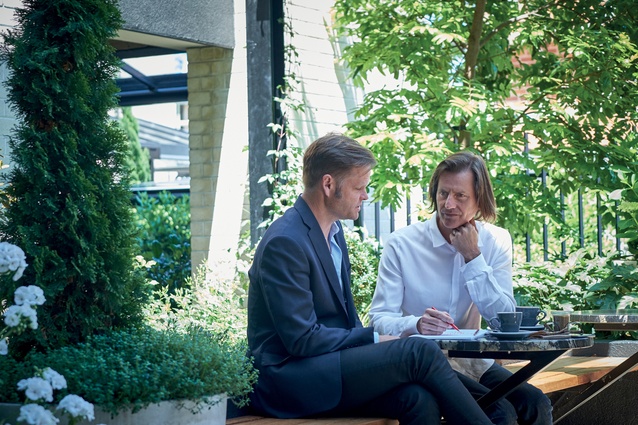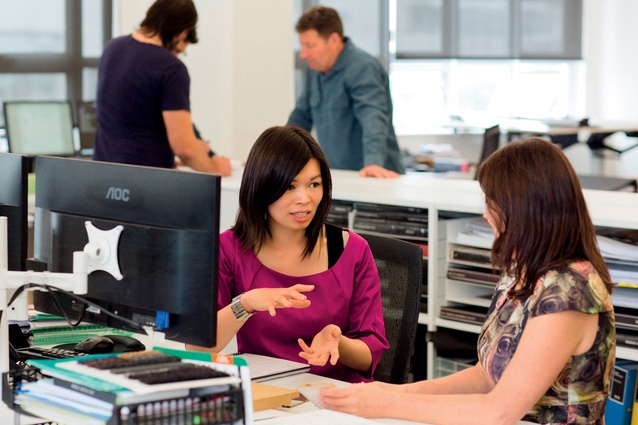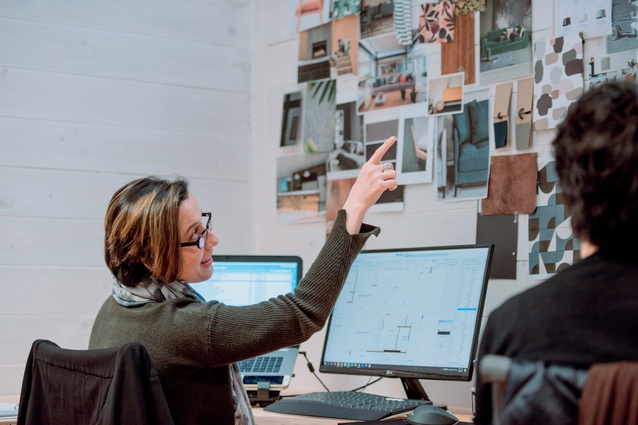Flexible working in architecture: Part two
Four architects weigh in on breaking the mould of traditional work hours and contracts within the industry.
Forty hours in four days
Stevens Lawson Architects has been running a four-day working week for more than 16 years. Director Gary Lawson explains how the four-day model works for the practice.
Forty hours in four days. We work from Monday to Thursday but they are ten-hour days. We generally all work set hours; we do 8am–1pm and then an hour for lunch – because you need a good break – then 2–7pm. You get used to the long days pretty quickly. Most people’s comments are that they work those kinds of hours anyway but for five days per week.
Flexibility within the structure. In the early days, when the practice was a bit smaller, everyone did the same hours but, now, some of our staff have children and those kinds of commitments so we allow a bit more of a flexible working week. Some people work slightly shorter hours from Monday to Thursday, then they might do a four or five-hour day on the Friday to make up their 40 hours.
So we have quite a lot of adaptability for individual staff members with different needs. As Auckland has grown and people live further out, some start slightly later and the same if they have kid drop-offs. But what we try and do is have the hours people are working clear so there is a routine for each person; otherwise, it’s a bit hard to keep track of what everyone is doing. There are fewer people doing flexible hours than not.
It’s proved sustainable. We have been running for 16 years and we have been doing this since day one. Nicholas (Stevens) floated the idea early on. The thought was to try to make the career sustainable. Rather than doing mad hours and burning out or getting resentful, we find that the three-day weekend is quite refreshing.
You come back to work on the Monday feeling like you have had a good break from the office. We have had really good levels of staff retention and, generally, people aren’t too strung out, which is a good advantage. Some people know about it when they come to a job interview; some are amazed when you tell them.
Keeping it in the office. Nicholas and I work from home sometimes but the rest of our staff members don’t do that often. Remote work is not something we have needed to do. Architecture is a funny thing; it’s office based and collaborative. There’s a bit of email work but, even with laptops, you also need the software and a fairly grunty system.
A day off. Originally the idea was, on a Friday, Nicholas and I would either have design time together – uninterrupted creative time – or we would go to an art gallery or have some creative stimulation out of the office environment. For the staff, it’s a day off – they can do things like doctors’ appointments, haircuts and that sort of thing. Some people use it to catch up on work, if they are behind, as an overtime day. Other people might do a bit of studio tutoring at the university. Or they just take a break. It’s their time.
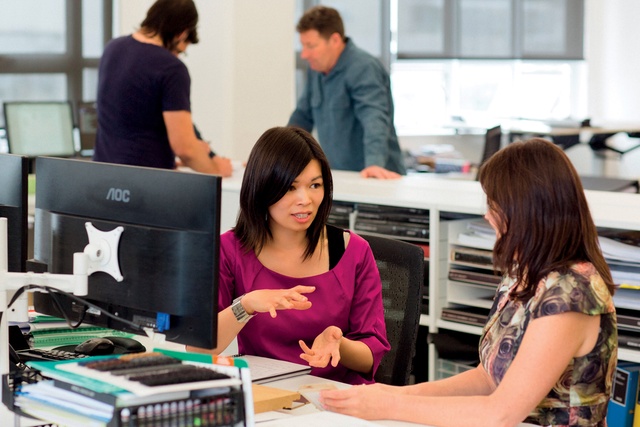
Reducing barriers through technology
Ewan Brown from Tennent Brown Architects wanted to reduce the barriers for certain staff members being out of the office by using a system that allows access to the office server from anywhere.
Developing effective technology. We built our own cloud server that we all dial into through the internet. We run Revit software, which is a very data-hungry system; it is hard to get working from a distance but we have our office of 19 people working on it and it has a very big graphics card and server. Everything in the office is just screens and tiny computers, which help the pack of information flow back and forth and make the screens work. It means staff can dial in from anywhere and all the processing power is external.
So, what you access from home is the same as what you see at work. It allows every machine to be a high-end Revit machine. We have had it running about for four years. I set it up partially because I like the flexibility and it meant we could establish an office anywhere, any time and have full access to our whole server, so there are no boundaries. This is also disaster resilient – if there’s an earthquake that takes out our building, we can continue working from elsewhere.
A two-way street. There is an expectation from clients that you are always there for them so we had some problems early on when someone wasn’t there one day per week and one of us had to jump in when we didn’t know where things were at with a project. So, for those staff members who we have that flexibility with, we don’t expect them to work on their days off, but there is sometimes an expectation that they will be happy to help when they can if we need it. It goes both ways.
Remote working. We have an American staff member who has been with us for a couple of years and is moving back to New York State where he is from. He is very skilled and charming and we will miss him – and we have a large project of two nine-storeyed buildings in which he has been involved – so, for the initial phase of things, we will keep him on the server.
We’re working on our Skype conferencing and seeing if we can get it so we can draw on the screen from both ends and both see what the other draws. That is my latest project. So, he will keep working for us from the US. He can dial into the server and he will see the system as he sees it here. He can even print through our photocopier and we can come in the next morning and see what he’s done; it will be sitting there waiting for us.

An individual approach
Dave Strachan, director of Strachan Group Architects (SGA), takes an individual approach to contracts, hours and pay. He works with each staff member to ensure they are happy with their arrangements and that no one is ‘taking the piss’. He talks about the way in which the Kingsland-based firm helps staff to balance work and life.
It’s about satisfaction. Job satisfaction is critical for us at SGA so being able to balance the demands of home life with work life makes sense. Depending on the situation, some fathers and mothers need to do pick-ups or drop-offs for daycare, or kids might be sick, so, given our digital platforms, the ability to do some work from home is an advantage. Maternity leave is often an unknown – it could be three, six or nine months or a year – because mothers often don’t know at the outset what time will suit them or their families, so we need to be flexible to accommodate that.
Pay reflects hours. We discuss changes in work schedule on an individual basis so, currently, anything from a 10 to a 20 per cent reduction in salary and hours worked suits some of the SGA team. Some partners can earn more than the other can so, for the particular family, it makes sense to split the parental time accordingly. Some team members prefer early starts and finishes, while others prefer late starts and finishes; this is OK as long as the work is done and the hours are consistent with the individual contract.
The remote office can work for architecture to a degree. We have a couple of ‘flexi-computers’ and iPads, and, of course, much of the email and phone call communication can be done via the phone and data packages provided. We also encourage partial contact and even small bits of work to be done during maternity leave situations where time allows.
There is still a need for face-to-face teamwork as well so I don’t think architecture can be purely a remote working option, as a lot of the learning and sharing of knowledge and project critique is often carried out informally within our studio environment. Plus, it’s important to feel part of a team, with the humour, banter and support that a team can offer. We are family. One of our SGA 10 core principles is ‘respect our work family and don’t take the piss’ so it’s all about balancing respect and flexibility in your work and home lives.
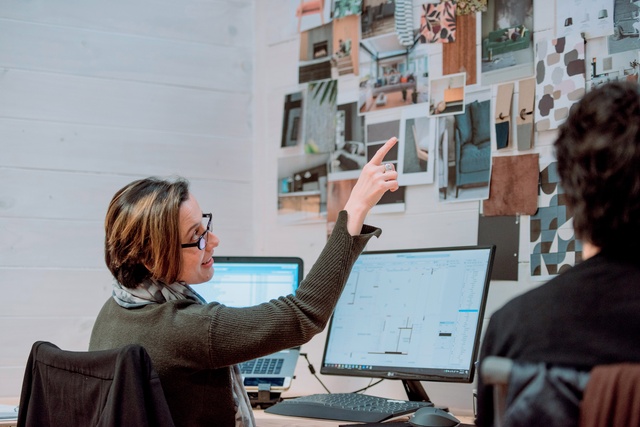
Beyond the nine to five
Designer and mum Melanie McDaid has just started a new architectural practice, Sloane & Peach, as well as co-founding a platform that is supportive of flexible working for all. Here, she talks about the future of balancing work and life.
Returning to work after more than a year of maternity leave, I’ve spent plenty of time thinking about how to balance working – including staying ‘current’ in my profession and contributing financially to our family – with what also works best for my daughter. I’ve realised that I’m not the only one thinking about this. I’ve also realised that working life as I know it is coming to an end. At least I hope so.
The nine to five is outdated and unkind. “The nine to five is barbaric. I really believe that. I think that, one day, we will look back at nine-to-five employment in a similar way to the way in which we see child labour in the 19th century.” Among a growing number of commentators, Douglas Coupland is leading the way in trying to shape a new way of living – away from working nine to five, Monday to Friday. “The future will not have the nine to five. Instead, the whole day will be interspersed with other parts of your life. Scheduling will become free-form.” I love this.
My day, a day I will never live again, will be mine to squeeze and shape so I can get and give the most out of it: the most to my family, my friends, my profession, myself and the person or people paying me for my work. We all have 168 hours a week and, as they say, no one on their deathbed wishes they had spent more time working. I believe we should be freer to make different choices about how we use this time.
It isn’t just about being a parent. All of this became real to me when I became a mother and my nine to five wasn’t as clean-cut as it used to be. However, the desire for flexibility is not exclusive to parents. This flexibility should be available to everyone – everyone with a life to lead.
A lot of the time, the work-life balance issue is a discussion around the demands of being a mother. However, the conversation must start to become a non-gender-specific discussion, encompassing all interests outside of work. If parents need flexibility around their working hours, why can’t the same flexibility be extended to those who don’t have children but have other commitments that are just as important to manage and balance? We need to be more humane with our workforce.
Being productive and getting the job done. We have to meet our targets, deadlines and goals. We all have different ways of getting our jobs done and an intelligent employer recognises this. Predicting the way of the working future, well-known investment-management firm BlackRock is leading the way with its flexible time-off policy, where employees can have as much paid time off as they want. Importantly, they still have the same performance targets – they just have more flexibility about how they meet them.
Other companies, many in the technology industry, which is known for its generous benefits and other employment offerings, have also been experimenting with unlimited paid time off in different forms. Here in New Zealand, Perpetual Guardian is experimenting with a four-day working week. Anecdotal evidence so far from these innovative firms shows that these policies – which are built on trust, consideration for one another and collaboration – are indeed working and that employees are not abusing them. Employees also report better satisfaction at work and thrive on the flexibility these policies offer them.
The business case for flexible working is strong. If an employer offers truly flexible working, they are more likely to attract and retain talent. With the assistance of cloud technology, flexible working can also help consolidate office space, which brings about cost savings. Research is also starting to emerge which confirms what we all intuitively know: that flexible working improves productivity, efficiency and engagement.
Furthermore, beyond financial performance, there are a number of benefits to businesses. Employees are more likely to describe relations between themselves and managers as good or very good where flexible working arrangements are made available to them. Surveys also show that employees who regularly work flexibly are more likely to work long hours, are off work less frequently and are less likely to leave their jobs. Other research has shown higher levels of well-being and less stress among employees with greater autonomy in their work.
It’s about people. The business case for flexible working is strong but, as is often the case, it’s also a very human issue. If the employer has the confidence in employees to allow them to give focus, time and attention to those things that are important in their lives outside of work, they will repay that confidence with appreciation and commitment. There is not one single measure of success. Success, for me, is having purpose in what I do.
Many people consider success as achieving the right balance between their personal and professional lives. That balance changes as our lives develop and grow, and flexible working is essential for achieving this. My hope is that the working day as we know it is coming to an end. I love the idea that, in the future, our workdays will be happily integrated with our home lives and our leisure. Those who want to can adapt to this free-form schedule. That sounds like a good future to me.

